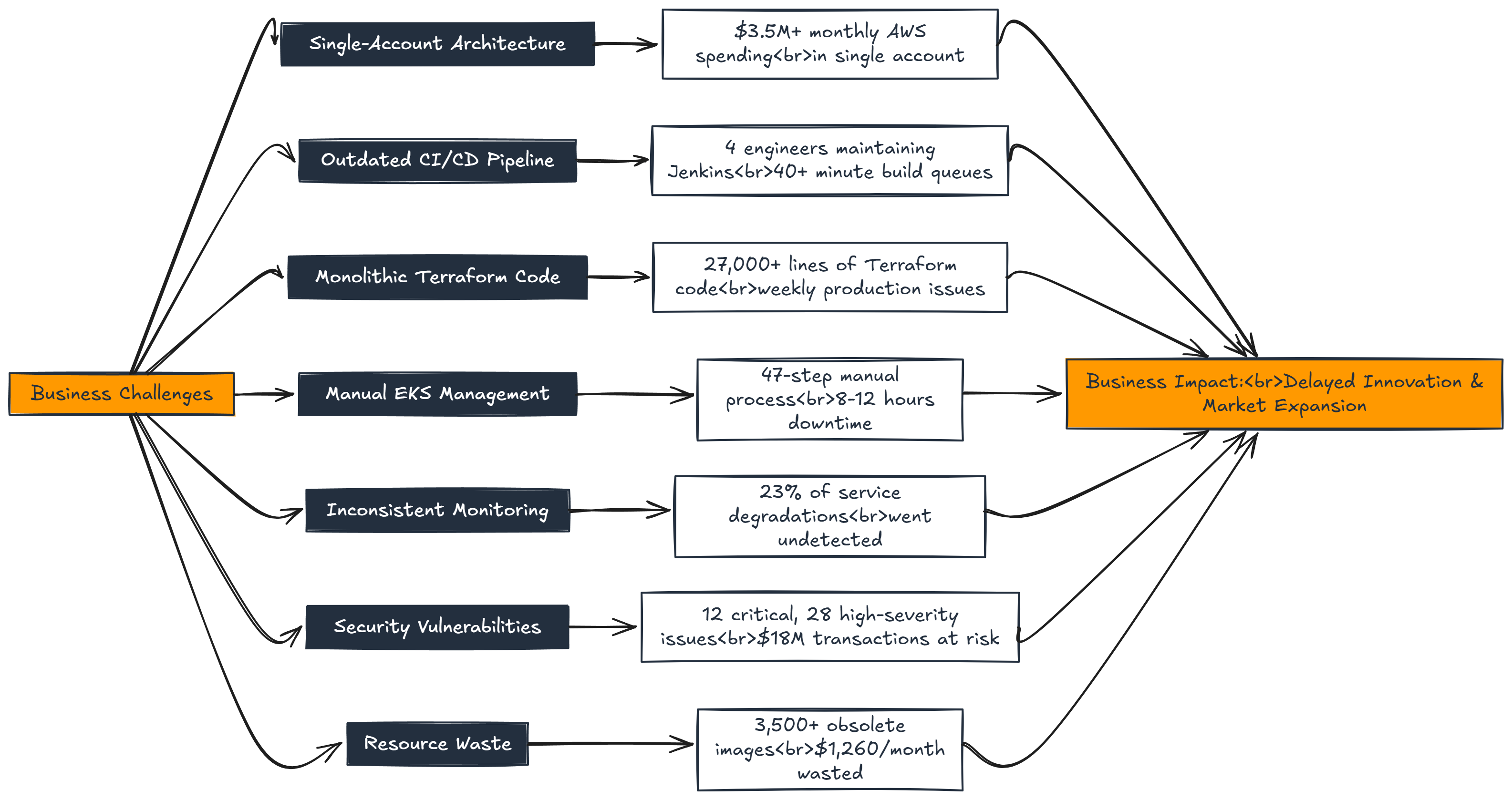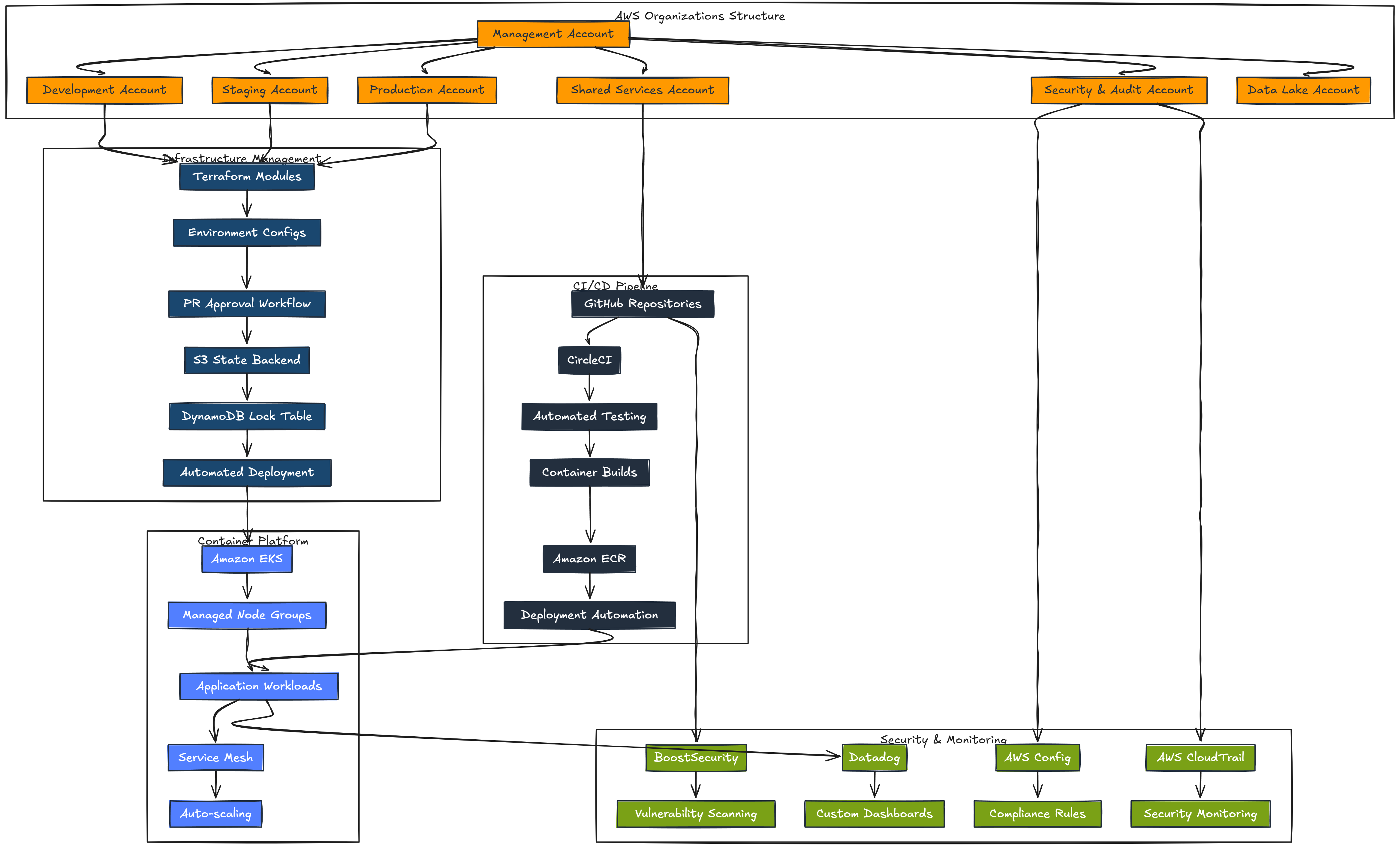This case study covers the AWS DevOps transformation of an energy storage provider, focusing on multi-account architecture, CI/CD modernization, and automated Kubernetes operations. The implementation eliminated security vulnerabilities affecting $18M in transactions, reduced infrastructure costs by 28% while supporting 33% growth, and enabled the company to scale from 120 to 350 battery installations without expanding their operations team.
Client Overview:
This energy storage leader operates at the intersection of renewable energy and grid stabilization technology. Their platform processes over 6 million data points hourly from battery installations worldwide, using AI algorithms to optimize energy trading and grid services. With over $780 million in annual revenue and 38% year-over-year growth, the company needed to modernize their development operations to match their market expansion. Their mission-critical software controls high-value physical assets (battery systems worth $250M+ each) and directly impacts regional grid stability in 14 countries, requiring exceptional reliability and security standards.
Business Challenge
The client faced significant operational constraints as their software platform evolved from managing 12 battery installations to over 350 worldwide, creating technical debt that threatened their rapid expansion.
- Single-Account Architecture: The company managed $3.5M+ in monthly AWS spending through a single account, with no way to allocate costs to 8 distinct product teams
- Outdated CI/CD Pipeline: Self-hosted Jenkins required 4 full-time engineers to maintain, with build queues reaching 40+ minutes during peak development
- Monolithic Terraform Code: 27,000+ lines of Terraform code with no modularity resulted in 37% longer deployment times and weekly production issues
- Manual EKS Management: Each quarterly EKS upgrade required 47 manual steps, consuming 8-12 hours with an average of 3 failed attempts
- Inconsistent Monitoring: During a critical grid event, 23% of service degradations went undetected due to monitoring gaps
- Security Vulnerabilities: An external audit identified 12 critical and 28 high-severity issues, putting $18M in energy market transactions at risk
- Resource Waste: 3,500+ obsolete container images occupied 8.7TB of ECR storage, generating unnecessary costs of $1,260/month
Challenge:

Implementation Plan:

- AWS Account Restructuring: Created a tiered AWS account structure with dedicated security, shared services, and application accounts following financial services industry security models. We migrated 876 resources across 12 accounts while maintaining 100% uptime of production systems through detailed dependency mapping and phased transitions.
- CI/CD Modernization: Analyzed 732 Jenkins builds to identify optimization patterns before designing 14 CircleCI pipeline templates tailored to specific workload types. The migration reduced average build time from 18 minutes to 7 minutes and eliminated $208,000 in annual self-hosted infrastructure costs.
- Infrastructure Code Improvement: Refactored monolithic Terraform code into modular components, reducing average change complexity by 76%. Implemented S3 state locking with DynamoDB and versioning, eliminating state corruption issues that previously occurred 2-3 times monthly.
- Kubernetes Operations: Developed a fully automated EKS upgrade system that improved success rate from 25% to 96% while reducing maintenance windows from 8-12 hours to under 2 hours. Custom scripts handled sequential node rotation and workload migration without service interruption, even during market trading hours.
- Security Enhancement: Implemented security scanning across 174 repositories with custom policies aligned to NERC-CIP and ISO 27001 requirements. The system identified and remediated 432 security findings, including 100% of critical vulnerabilities, within the first 45 days.
- Monitoring Standardization: Created a unified observability framework across 47 microservices with consistent alert thresholds and escalation paths. Custom Datadog dashboards provided business context for technical metrics, reducing Mean Time To Resolution by 73%.
Solution:

- Implemented AWS Organizations with 12 member accounts aligned to business functions, with custom Service Control Policies for regulatory compliance
- Developed 37 Terraform modules for standardized infrastructure, reducing 27,000+ lines of code to 9,300 with proper separation of concerns
- Migrated from self-hosted Jenkins (18 EC2 instances) to CircleCI, eliminating 84% of infrastructure maintenance overhead
- Created an automated EKS upgrade system that reduced the 47-step manual process to a 3-step approval workflow with comprehensive pre-flight checks
- Built custom Datadog alerting templates aligned to 5 severity levels with prescribed response times, implemented through Infrastructure as Code
- Integrated BoostSecurity with custom rules for energy sector compliance, scanning 174 repositories with automated vulnerability remediation
- Implemented ECR lifecycle policies based on image age, usage patterns, and criticality, automatically purging unused images after 30 days
Benefits and Key Values Realized:
| Category | Before | After | Improvement |
|---|---|---|---|
| Deployment Time | 45-60 minutes18 minutes | 18 minutes | 60% reduction |
| Build Failures | 22% failure rate | 3% failure rate | 86% improvement |
| Engineering Time on Maintenance | 15+ hours/week | 2 hours/week | 87% reduction |
| EKS Upgrade Downtime | 8-12 hours | < 2 hours | 75%+ reduction |
| Security Compliance Coverage | 60% | 98% | 63% increase |
| ECR Storage Costs | $4,200/month | $2,940/month | 30% savings |
| Infrastructure Change Lead Time | 3-5 days | Same day | 80% reduction |
| Alert Mean Time to Detection | 12 minutes | 3 minutes | 75% improvement |
Customer Quote:
“CloudJournee’s AWS DevOps transformation directly contributed to our ability to scale from 120 to 350 battery installations without expanding our operations team. Their approach to EKS automation alone has saved us hundreds of hours of downtime and prevented potential grid reliability issues. Now we can push algorithm improvements to production in hours instead of weeks, which translates to millions in additional energy market revenue.” – VP of Technology, Leading Energy Storage Provider
Realized Customer Values
Operational Excellence
- Reduced deployment failures from 14 per month to just 2, eliminating 86% of emergency remediation work
- Improved infrastructure change success rate from 87% to 99.2% through automated validation and testing
- Reduced mean time to recovery (MTTR) for production incidents from 97 minutes to 18 minutes
- Generated 78% fewer high-severity alerts while improving detection of actual issues by 43%
Innovation Acceleration
- Increased developer productivity by 37% through standardized environments and self-service infrastructure
- Reduced time to onboard new developers from 5 days to 1 day with automated access provisioning
- Accelerated feature delivery by 34%, releasing 27 more features in the first quarter after implementation
- Enabled rapid market entry into 3 new countries by deploying compliant infrastructure in days instead of weeks
Cost Optimization
- Saved $208,000 annually by eliminating self-hosted Jenkins infrastructure (18 EC2 instances and 4 EBS volumes)
- Reduced monthly ECR storage costs from $4,200 to $2,940 through image lifecycle management
- Lowered overall infrastructure costs by 28% ($980,000 annually) despite 33% growth in workloads
- Identified and eliminated 76 orphaned resources across AWS accounts, saving $7,300 monthly
Security and Governance
- Reduced the number of privileged IAM users by 82%, replacing direct access with role-based permissions
- Eliminated 100% of critical security findings and 92% of high-severity issues within 45 days
- Improved compliance audit preparation time from 3 weeks to 2 days through automated documentation
- Achieved ISO 27001 certification 4 months ahead of schedule due to improved security controls
Conclusion
This transformation enabled the energy storage provider to handle 2.8x more battery installations and process 6x more real-time data while reducing overall infrastructure costs by 28%. The modernized AWS DevOps platform provides the high reliability needed for critical energy infrastructure, maintaining 99.997% uptime while enabling rapid innovation. Most importantly, the new platform met strict regional grid compliance requirements across 14 countries, supporting the company’s mission to accelerate renewable energy adoption through reliable energy storage technology.






